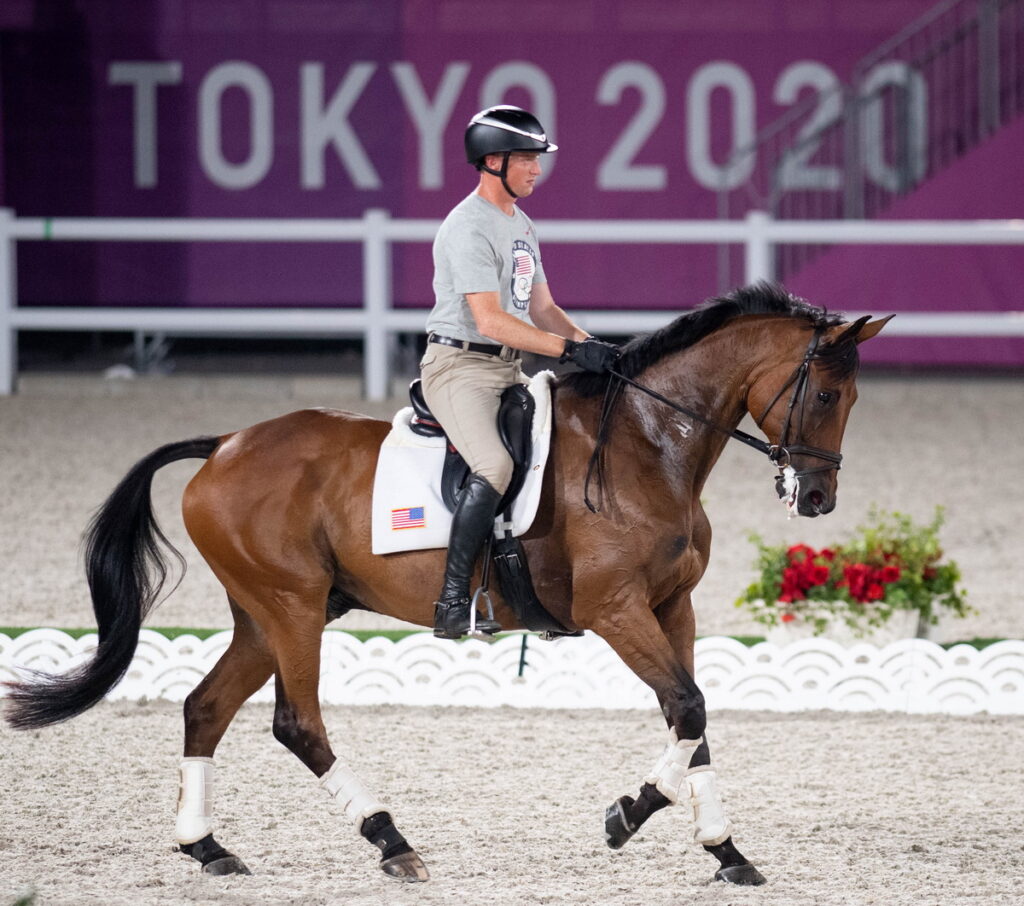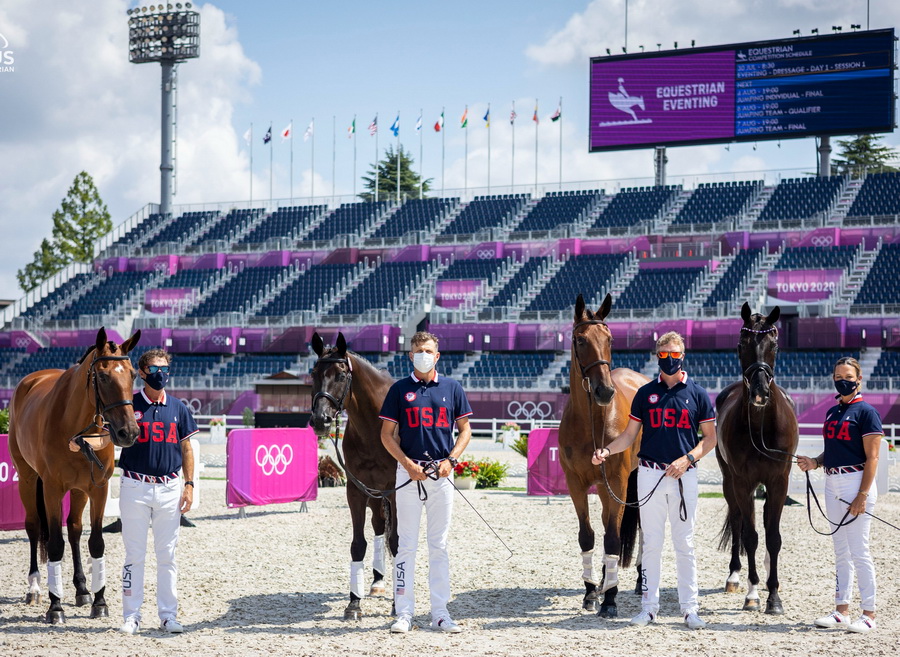There were a few surprises in the dressage competition at the Olympics; the U.S. got its first team silver in the discipline since 1948, and there was a new face on the highest level of the podium after the individual competition.
No one was surprised, however, when Germany won team gold for the 14th time, and many familiar names–even with new horses–did well.
But eventing in Tokyo, which gets under way Thursday evening Eastern Daylight Time, will be a whole different story. The dearth of top-level eventing since the spring of 2020 due to Covid means horses might not be in their usual form and we may not be aware of new contenders with the potential to win.
With only three on a team and no drop score, the ability to substitute a horse/rider combination during the competition comes with penalties, which make the sport harder to understand. Even those who have followed it for years are on a learning curve. As a result, it’s also more difficult to handicap. And we all know anything can happen in eventing under any circumstances, let alone the Olympics.
For the U.S. squad, preparation has gone “according to plan,” said the discipline’s performance director, Erik Duvander, noting the idea always was that team contenders would compete primarily in America in the run- up to the Games. With Covid, as it happened, there was little choice about traveling to foreign competitions. .
“If we had planned to go abroad, it would have been different,” Erik pointed out, but as it was, only one or two horses originally might have wanted to go to Great Britain’s 5-star Badminton Horse Trials before it was cancelled in May for the second time.
Key to the American lead-up was April’s Land Rover Kentucky 5-star, which was called off and then went ahead after a grassroots fundraising campaign. A Kentucky outing was vital because the cross-country was designed by Derek di Grazia, who is also laying out the Olympic cross-country route at Sea Forest, a former landfill on the water. The horses will be based at the Baji Koen equestrian park for the dressage and stadium jumping phases, and travel to Sea Forest Friday night Japanese time, which is 13 hours ahead of EDT.
In Kentucky, said Erik, “Derek built a very, very good track this year, as he always does, but this one was particularly good. I think we learned a lot from riding around there.”
The team of three and an alternate was changed when Liz Halliday-Sharp’s ride, DeNiro, was injured. Doug Payne and Vandiver were tapped to replace her on the team, which also includes perennial members Phillip Dutton (Z) and Boyd Martin (Tsetserleg). Tamie Smith and Mai Baum are the traveling reserves.

Doug Payne and Vandiver in the ring familiarization at Baji Koen. (Photo courtesy of U.S. Equestrian)
After walking the course, Phillip concluded, “Derek has made people think and decide what line they want to take. It’s not the biggest course I’ve ever walked, but there’s plenty there to do.”
He cited, “Thinking all the time…pushing things to stay on the clock.”
Boyd said the course is “very difficult just because it’s on a twisting piece of land. I think it’s going to feel big because you’re sort of stopping and starting and going left and right and up and down. Even though it’s 7 minutes 45 (seconds) I think the horses will be pretty winded just because there’s a lot of sprinting and stuff. I think Derek’s built a top track because there’s not one wicked influential jump,” he continued, mentioning tricky traps set the whole way around the course, from the fourth fence, the first jump into the water, until the last combination. The course is way harder if you have a crack at the time and go the direct lines and take chances.”
Doug said with the land Derek had available, he’s done an excellent job to make use of it. He compared it to the 4-star short at Tryon, N.C.
“Everyone’s goal is to be as smooth and easy on the horses as possible. I’m quite happy to have Vandiver here. He’s really quick horse in general… it will help your horse a lot if you know the land and know your line from start to finish within a couple of inches. It would be very easy to get caught out a little bit off one way or the other and have a pretty big impact on your round. The time’s going to be challenging for sure.
The riders were thrilled with the facilities for training and the climate-controlled stables. “Horse friendly,” is how Phillip put it.
At the same time they’re dealing with the inconvenience caused by Covid, the heat,and social distancing, they’re focusing on the competition.
“It’s been an Olympics like no other, ” said Boyd.
“You can whinge and whine about how inconvenient and this and that,” he observed, but added the situation needs to be kept in perspective.
“It’s fantastic being here. I think you can enjoy the moment. It’s unique, it’s different. I think in years to come, we’ll look at photos on the wall wearing masks and no spectators and think, `Holy hell, what a weird time that was.’
“It’s different, but it’s a special moment in all of our careers. and at the end of the day, the dressage arena is the same size, the same number of judges,” Boyd pointed out.
“It doesn’t matter if one person is watching or 50,000 people are watching, you’ve still got the same job to do, so it’s important you don’t get focused on things that are difficult or inconvenient.”
Doug rides at 7:42 EDT today (Thursday), Phillip at 5 a.m. EDT Friday and Boyd at 8:28 p.m. EDT that evening.
If you can’t watch the livestream and want to keep up with what’s happening, come back here to read my live blog for the moment-to-moment action. With a delay, you can watch highlights on NBC Sports Network on Friday from 3:15-4:15 p.m. EDT. That program will also include the second segment of eventing dressage that starts at 4:30 a.m. EDT Friday.
Want to follow German superstar Michael Jung? He rides next-to-last Friday evening at 9:44 p.m. EDT. Those rooting for Canada will have to be content with seeing just Colleen Loach and Qorry Blue D’Argouges.at 9:26 EDT Thursday. The other Canadian entry, Jessica Phoenix’s Pavarotti, was withdrawn before the horse inspection.after sustaining a minor injury on their last gallop.
Erik came to the U.S. program in 2017 and immediately was faced with organizing things for the FEI World Equestrian Games in 2018. He found the contenders were not quite ready, with a group of young horses at the fore. The team finished eighth of 16 squads.
Three years on, Tsetserleg and Z are more mature and Doug has quite a resume with Vandiver. Tamie and Mai Baum are also proven entities.
While the U.S. doesn’t really figure among the hottest favorites for the team medals, as I said, handicapping is tough because of the three-member format, the heat horses will face cross-country through the morning (dressage and jumping will be held during cooler times of the day) and how the substitutions will figure in the picture. But America has three good horse/rider combos (four if you count the talented alternate) and the determination to make their mark.

The U.S. team: Phillip Dutton (Z), Boyd Martin (Tsetserleg), Doug Payne (Vandiver) and Tamie Smith (Mai Baum). (Photo courtesy of U.S. Equestrian)
The short odds are for the British, with Oliver Townend on their side. Also a factor are the Germans, led by three-time Olympic gold medalist Michael Jung (two individual golds and one team gold). The husband/wife team of Tim and Jonelle Price will make New Zealand a nation to watch in term of medal possibilities. And Australia, with veteran Andrew Hoy leading the way, can be dangerous as well.
But the withdrawal of the formidable Chris Burton after his horse suffered a slight injury means that nation won’t be quite as much of a contender as it would be with him on its roster.
Meanwhile, keep an eye on the Japanese–I was impressed at the 2018 WEG, when those riders took the short way out of a troublesome water complex, which made me think they could put in a bid.
Individually, Ollie and Michael Jung are the big players, along with Tim Price, number two in the world. But there’s always room for a dark horse or two in eventing, so maybe Boyd or Phillip will find a spot to slide onto the podium.




